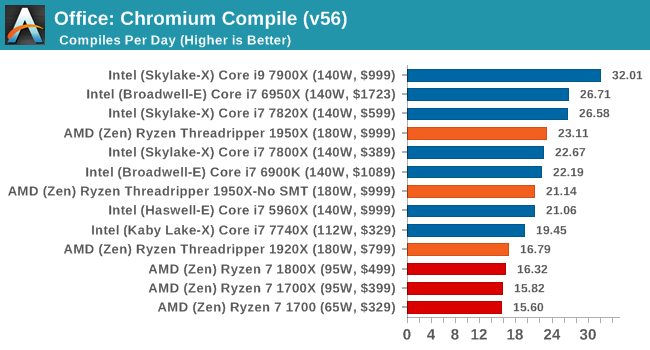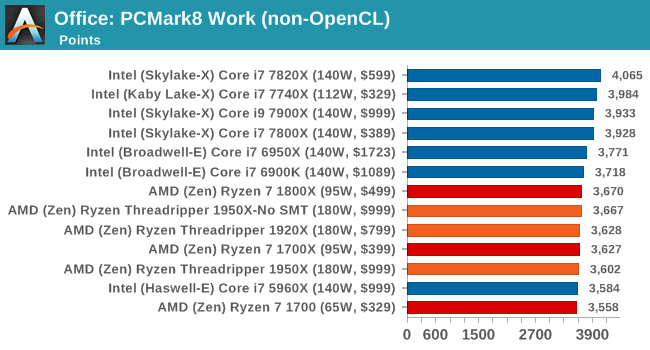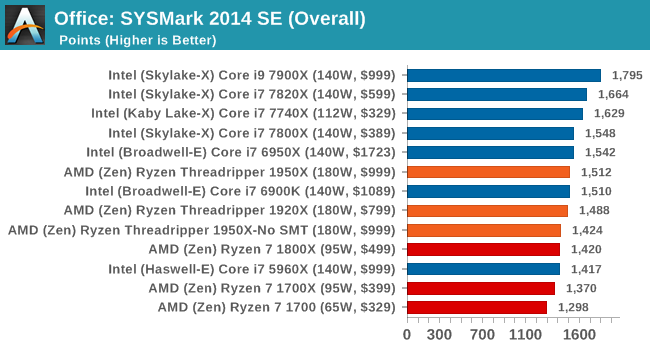The AMD Ryzen Threadripper 1950X and 1920X Review: CPUs on Steroids
by Ian Cutress on August 10, 2017 9:00 AM ESTCPU Office Tests
The office programs we use for benchmarking aren't specific programs per-se, but industry standard tests that hold weight with professionals. The goal of these tests is to use an array of software and techniques that a typical office user might encounter, such as video conferencing, document editing, architectural modeling, and so on and so forth.
All of our benchmark results can also be found in our benchmark engine, Bench.
Chromium Compile (v56)
Our new compilation test uses Windows 10 Pro, VS Community 2015.3 with the Win10 SDK to compile a nightly build of Chromium. We've fixed the test for a build in late March 2017, and we run a fresh full compile in our test. Compilation is the typical example given of a variable threaded workload - some of the compile and linking is linear, whereas other parts are multithreaded.

One of the interesting data points in our test is the Compile, and it is surprising to see the 1920X only just beat the Ryzen 7 chips. Because this test requires a lot of cross-core communication, the fewer cores per CCX there are, the worse the result. This is why the 1950X in SMT-off mode beats the 3 cores-per-CCX 1920X, along with lower latency memory support. We know that this test is not too keen on victim caches either, but it does seem that the 2MB per core ratio does well for the 1950X, and could explain the performance difference moving from 8 to 12 to 16 cores under the Zen microarchitecture.
PCMark8: link
Despite originally coming out in 2008/2009, Futuremark has maintained PCMark8 to remain relevant in 2017. On the scale of complicated tasks, PCMark focuses more on the low-to-mid range of professional workloads, making it a good indicator for what people consider 'office' work. We run the benchmark from the commandline in 'conventional' mode, meaning C++ over OpenCL, to remove the graphics card from the equation and focus purely on the CPU. PCMark8 offers Home, Work and Creative workloads, with some software tests shared and others unique to each benchmark set.


Strangely, PCMark 8's Creative test seems to be failing across the board. We're trying to narrow down the issue.
SYSmark 2014 SE: link
SYSmark is developed by Bapco, a consortium of industry CPU companies. The goal of SYSmark is to take stripped down versions of popular software, such as Photoshop and Onenote, and measure how long it takes to process certain tasks within that software. The end result is a score for each of the three segments (Office, Media, Data) as well as an overall score. Here a reference system (Core i3-6100, 4GB DDR3, 256GB SSD, Integrated HD 530 graphics) is used to provide a baseline score of 1000 in each test.
A note on context for these numbers. AMD left Bapco in the last two years, due to differences of opinion on how the benchmarking suites were chosen and AMD believed the tests are angled towards Intel processors and had optimizations to show bigger differences than what AMD felt was present. The following benchmarks are provided as data, but the conflict of opinion between the two companies on the validity of the benchmark is provided as context for the following numbers.











347 Comments
View All Comments
Ian Cutress - Thursday, August 10, 2017 - link
We ran with both and give the data for both. Gaming Mode is not default, and it may surprise you just how many systems are still run at default settings.mapesdhs - Thursday, August 10, 2017 - link
Just a thought, might it be possible for AMD to include logic in the design which can tell when it's doing something would probably run better in the other mode, and if so notify the user of this?zepi - Thursday, August 10, 2017 - link
Which 7-zip version are you actually using? Do you really run version 9.2 as stated in the article?Latest stable should be something like 16.x and 17.x's are also available.
zepi - Thursday, August 10, 2017 - link
Your numbers look somewhat different compared to some sites that have been using 17.x versions.DanNeely - Thursday, August 10, 2017 - link
Keeping the version constant means you can compare against a huge backlog of old data without having to rerun anything and having to drop any systems you can't get working or were only loaners.Alexey291 - Thursday, August 10, 2017 - link
Yes and also means that the results are useless.tamalero - Thursday, August 10, 2017 - link
Agree. Its like running a benchmark suit that cant handle more than 8 threads.. because "back in the days" there were only dual core processors.Johan Steyn - Thursday, August 10, 2017 - link
Its called slanted journalism, just another example.zepi - Friday, August 11, 2017 - link
Exactly. We don't test GPU's with Quake 2 only to have comparable benchmark results against Voodoo 3.And almost no-one running 7zip today (be it on Core 2 quad OR Core i9) won't be running these ancient versions. Results on those versions are just meaningless in todays environment.
zepi - Friday, August 11, 2017 - link
princess and half a kingdom for functional edit.